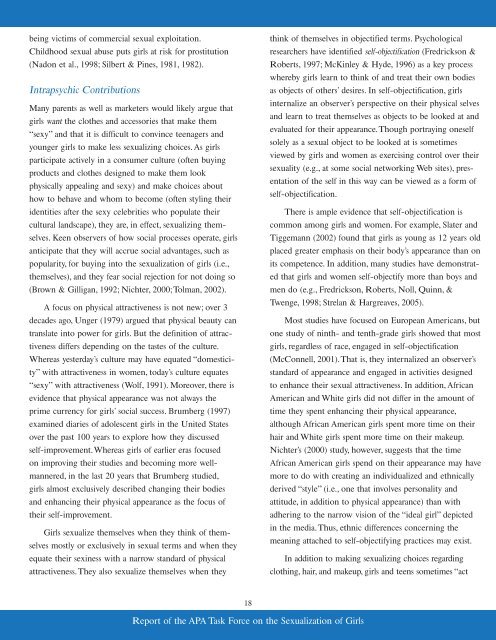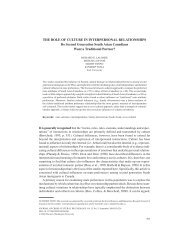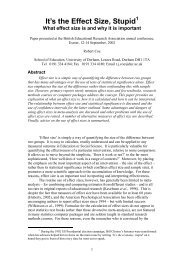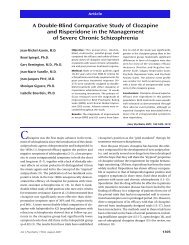SexualizationofWomen.. - Department of Psychology - York University
SexualizationofWomen.. - Department of Psychology - York University
SexualizationofWomen.. - Department of Psychology - York University
Create successful ePaper yourself
Turn your PDF publications into a flip-book with our unique Google optimized e-Paper software.
eing victims <strong>of</strong> commercial sexual exploitation.<br />
Childhood sexual abuse puts girls at risk for prostitution<br />
(Nadon et al., 1998; Silbert & Pines, 1981, 1982).<br />
Intrapsychic Contributions<br />
Many parents as well as marketers would likely argue that<br />
girls want the clothes and accessories that make them<br />
“sexy” and that it is difficult to convince teenagers and<br />
younger girls to make less sexualizing choices. As girls<br />
participate actively in a consumer culture (<strong>of</strong>ten buying<br />
products and clothes designed to make them look<br />
physically appealing and sexy) and make choices about<br />
how to behave and whom to become (<strong>of</strong>ten styling their<br />
identities after the sexy celebrities who populate their<br />
cultural landscape), they are, in effect, sexualizing them-<br />
selves. Keen observers <strong>of</strong> how social processes operate, girls<br />
anticipate that they will accrue social advantages, such as<br />
popularity, for buying into the sexualization <strong>of</strong> girls (i.e.,<br />
themselves), and they fear social rejection for not doing so<br />
(Brown & Gilligan, 1992; Nichter, 2000;Tolman, 2002).<br />
A focus on physical attractiveness is not new; over 3<br />
decades ago, Unger (1979) argued that physical beauty can<br />
translate into power for girls. But the definition <strong>of</strong> attrac-<br />
tiveness differs depending on the tastes <strong>of</strong> the culture.<br />
Whereas yesterday’s culture may have equated “domestici-<br />
ty” with attractiveness in women, today’s culture equates<br />
“sexy” with attractiveness (Wolf, 1991). Moreover, there is<br />
evidence that physical appearance was not always the<br />
prime currency for girls’ social success. Brumberg (1997)<br />
examined diaries <strong>of</strong> adolescent girls in the United States<br />
over the past 100 years to explore how they discussed<br />
self-improvement.Whereas girls <strong>of</strong> earlier eras focused<br />
on improving their studies and becoming more well-<br />
mannered, in the last 20 years that Brumberg studied,<br />
girls almost exclusively described changing their bodies<br />
and enhancing their physical appearance as the focus <strong>of</strong><br />
their self-improvement.<br />
Girls sexualize themselves when they think <strong>of</strong> them-<br />
selves mostly or exclusively in sexual terms and when they<br />
equate their sexiness with a narrow standard <strong>of</strong> physical<br />
attractiveness.They also sexualize themselves when they<br />
18<br />
think <strong>of</strong> themselves in objectified terms. Psychological<br />
researchers have identified self-objectification (Fredrickson &<br />
Roberts, 1997; McKinley & Hyde, 1996) as a key process<br />
whereby girls learn to think <strong>of</strong> and treat their own bodies<br />
as objects <strong>of</strong> others’ desires. In self-objectification, girls<br />
internalize an observer’s perspective on their physical selves<br />
and learn to treat themselves as objects to be looked at and<br />
evaluated for their appearance.Though portraying oneself<br />
solely as a sexual object to be looked at is sometimes<br />
viewed by girls and women as exercising control over their<br />
sexuality (e.g., at some social networking Web sites), pres-<br />
entation <strong>of</strong> the self in this way can be viewed as a form <strong>of</strong><br />
self-objectification.<br />
There is ample evidence that self-objectification is<br />
common among girls and women. For example, Slater and<br />
Tiggemann (2002) found that girls as young as 12 years old<br />
placed greater emphasis on their body’s appearance than on<br />
its competence. In addition, many studies have demonstrat-<br />
ed that girls and women self-objectify more than boys and<br />
men do (e.g., Fredrickson, Roberts, Noll, Quinn, &<br />
Twenge, 1998; Strelan & Hargreaves, 2005).<br />
Most studies have focused on European Americans, but<br />
one study <strong>of</strong> ninth- and tenth-grade girls showed that most<br />
girls, regardless <strong>of</strong> race, engaged in self-objectification<br />
(McConnell, 2001).That is, they internalized an observer’s<br />
standard <strong>of</strong> appearance and engaged in activities designed<br />
to enhance their sexual attractiveness. In addition, African<br />
American and White girls did not differ in the amount <strong>of</strong><br />
time they spent enhancing their physical appearance,<br />
although African American girls spent more time on their<br />
hair and White girls spent more time on their makeup.<br />
Nichter’s (2000) study, however, suggests that the time<br />
African American girls spend on their appearance may have<br />
more to do with creating an individualized and ethnically<br />
derived “style” (i.e., one that involves personality and<br />
Report <strong>of</strong> the APA Task Force on the Sexualization <strong>of</strong> Girls<br />
attitude, in addition to physical appearance) than with<br />
adhering to the narrow vision <strong>of</strong> the “ideal girl” depicted<br />
in the media.Thus, ethnic differences concerning the<br />
meaning attached to self-objectifying practices may exist.<br />
In addition to making sexualizing choices regarding<br />
clothing, hair, and makeup, girls and teens sometimes “act

















